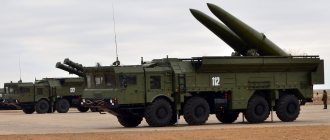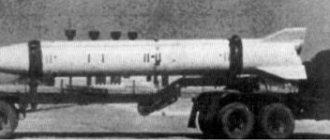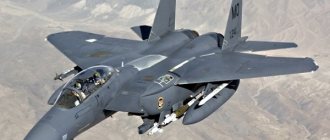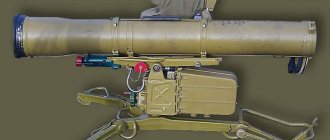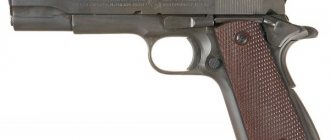Tactical missile system 9K52 "Luna-M"
In 1960, the 2K6 Luna tactical missile system was adopted by the missile forces and artillery. It differed from its predecessors in its improved characteristics, and was also built in large series, which made it possible to transfer several hundred complexes to the troops. Soon after the new model was adopted, it was decided to begin developing the next modification of the missile system. The new project received the designation 9K52 Luna-M. The resolution of the Council of Ministers of the USSR on the development of a promising missile system, which is a further development of existing systems, was issued in mid-March 1961. The development of the project as a whole was entrusted to NII-1 (now the Moscow Institute of Thermal Engineering), which had experience in creating tactical missile systems. The terms of reference stipulated the development of a single-stage ballistic missile without control systems, capable of hitting targets at ranges of up to 65 km. It was necessary to take into account the possibility of using several types of combat units. It was also necessary to develop two versions of a self-propelled launcher with different types of chassis and, as a result, different characteristics.
The main goal of the project, designated “Luna-M,” was to improve the basic tactical and technical characteristics in comparison with existing equipment. In addition, by one means or another it was proposed to improve the operational characteristics of the complex, as well as reduce its composition. Thus, it was proposed to equip the 9P113 wheeled self-propelled launcher with its own crane for working with missiles. This made it possible not to include a transport-loading vehicle or a self-propelled crane in the missile complex, making do with only relatively simple transporters. Some other ideas and solutions have also been proposed to improve overall performance.
Preparing the 9K52 Luna-M complex for rocket launch. Photo Rbase.new-factoria.ru
During the design work, employees of several defense industry organizations developed several launcher options at once. However, not all of them reached mass production and use in the army. Initially, self-propelled units were created on wheeled and tracked chassis, and later more daring proposals appeared, such as a lightweight system suitable for transportation by air.
The 9P113 self-propelled launcher was developed by several enterprises responsible for the supply of certain units. The basis for this vehicle was the four-axle wheeled chassis ZIL-135LM. The chassis had an 8x8 wheel arrangement with steered front and rear wheels. Two ZIL-357Ya engines with 180 hp each were used. The car had two sets of transmissions, each of which was responsible for transmitting engine torque to the wheels of its side. There was an independent torsion bar suspension with additional hydraulic shock absorbers on the front and rear axles. With its own weight of 10.5 tons, the ZIL-135LM chassis could carry a 10-ton load.
A set of special units was mounted on the cargo area of the chassis. Space was provided for mounting the launcher, crane, etc. In addition, a stabilization system was developed in the form of four screw jacks. A pair of such devices were placed behind the front wheels, and two more on the rear of the car. Due to the limited horizontal guidance sector, the cockpit received windshield protection.
Scheme of the 9P113 self-propelled launcher. 1 — cockpit; 2 - rocket; 3 - jack; 4 - stairs; 5 — box with equipment; 6 — engine compartment; 7 — crane boom; 8 - platform for calculation when loading a rocket; 9 - platform for calculation when pointing. Drawing by Shirokorad A.B. "Domestic mortars and rocket artillery"
It was proposed to mount a rotary support device for the missile launcher above the rear axle of the chassis. It was made in the form of a platform with the ability to rotate in a horizontal plane at a small angle. A swinging unit was hinged on the platform, the main part of which was a beam guide for the rocket. The length of the guide was 9.97 m. It was possible to rotate in the horizontal plane 7° to the right and left from the neutral position. The vertical guidance angle varied from +15° to +65°.
On the right side of the chassis, behind the third axle of the chassis, a slewing ring for the crane was placed. Even at the stage of preliminary development of the appearance of the missile system, it was proposed to abandon the use of a transport-loading vehicle in favor of a simpler transport one. In accordance with this proposal, the loading of missiles onto the launcher was to be carried out by the combat vehicle’s own crane. Because of this, the 9P113 machine received a crane with hydraulic drives. The lifting capacity of this device reached 2.6 tons. Control was carried out from a remote control located next to the crane itself.
The length of the 9P113 self-propelled launcher was 10.7 m, width - 2.8 m, height with a rocket - 3.35 m. The vehicle's own weight was 14.89 kg. After equipping the launcher, this parameter increased to 17.56 tons. The wheeled combat vehicle could reach speeds of up to 60 km/h on the highway. On rough terrain, the maximum speed was limited to 40 km/h. Power reserve – 650 km. An important feature of the wheeled chassis was its smooth ride. Unlike the tracked vehicles of previous missile systems, the 9P113 did not create excessive overloads that affected the transported missile and limited its speed. Among other things, this made it possible to put into practice all the possibilities associated with mobility characteristics.
Vehicle 9P113 in stowed position. Photo Rbase.new-factoria.ru
As in previous projects, ballistic missiles were not supposed to have control systems. For this reason, the self-propelled launcher received a set of equipment necessary for aiming. Using onboard equipment, the crew had to determine their own location and also calculate the launcher's pointing angles. Most of the operations to prepare the vehicle for firing were carried out using a remote control.
The 9P113 was to be driven by a crew of five people. During the march, the crew was in the cockpit, while preparing to fire or reload the launcher - at their workplaces. It took 10 minutes to prepare for launch after arriving at the firing position. Loading the rocket from the transport vehicle to the launcher required 1 hour.
Until a certain time, the possibility of creating a self-propelled launcher based on a tracked chassis for the 9K52 Luna-M complex was considered. A similar vehicle, designated Br-237 and 9P112, was developed by Volgograd. The project envisaged the use of a chassis borrowed from the PT-76 amphibious tank and redesigned accordingly. In place of the combat and engine compartments of the tank, it was proposed to place a low-height roof on which systems for mounting the launcher were located. The design of the latter was similar to that used in the 9P113 project. Development of the tracked combat vehicle project continued until 1964. After this, the prototype was tested at a test site, where it could not show any noticeable advantages over alternative designs. As a result, work on the Br-237 / 9P112 was curtailed due to lack of prospects.
The launcher is in firing position. Photo: Wikimedia Commons
Another interesting carrier of the Luna-M rockets was supposed to be the 9P114 light vehicle. This project proposed the use of a lightweight two-axle chassis with a set of necessary equipment. This launcher architecture made it possible to transport the 9P114 object by existing types of helicopters. Due to significant differences from the basic system, the complex based on the 9P114 launcher received its own designation 9K53 “Luna-MV”. Later, this system even managed to reach trial operation.
To work together with the 9P113, the 9T29 transport vehicle was developed. It was based on the ZIL-135LM chassis and had fairly simple equipment necessary to perform its main task. On the cargo platform of the chassis there was a truss with fastenings for transporting three missiles with installed warheads. The missiles were placed openly on the mounts, but could be covered with an awning if necessary. Due to the presence of a crane on the vehicle with the launcher, it was decided to abandon the use of such devices as part of the 9T29. The transport vehicle was driven by a crew of two people.
It was proposed to control the operation of the 9K52 Luna-M missile systems using the 1V111 mobile command post. It was a van body with a set of communication equipment, installed on one of the serial automobile chassis. The characteristics allowed the command post to move on roads and off-roads along with other equipment of the complex.
Tracked self-propelled launcher Br-237/9P112. Drawing by Shirokorad A.B. "Domestic mortars and rocket artillery"
The weapon of the Luna-M complex was to be the 9M21 solid-fuel single-stage unguided ballistic missile. The project proposed the use of a unified missile unit, to which warheads with several types of combat equipment could be docked. Unlike missiles of previous systems, products with different types of warheads were considered modifications of the base missile and received appropriate designations.
Early modifications of the 9M21 missiles had a length of 8.96 m with a body diameter of 544 mm and a stabilizer span of 1.7 m. A cylindrical body of high aspect ratio with a conical head fairing and an X-shaped tail stabilizer was used. The missile was divided into three main parts: the head with a warhead, the rotation engine compartment and the sustainer engine. It was also envisaged to use a starting engine that was reset after leaving the guide.
All rocket engines used solid fuel with a total weight of 1080 kg. Using the launch engine, it was proposed to carry out the initial acceleration of the rocket, after which the sustainer engine was turned on. In addition, immediately after leaving the guide, the rotation motor was turned on, whose task was to spin the product around its axis. This engine had a central cylindrical combustion chamber and four exhaust pipes placed on the housings at an angle to the axis of the product. After the rotation engine fuel was exhausted, stabilization was carried out using tail stabilizers.
Transport vehicle 9T29. Photo: Wikimedia Commons
Several types of warheads with different types of equipment were developed for the 9M21 missile. Continuing the development of the ideas contained in previous projects, the authors of the project created modifications of the missile with the designations 9M21B and 9M21B1, equipped with nuclear warheads. It was proposed to carry out the detonation at a given height using a radio altimeter. The power of the explosion reached 250 kt.
The 9M21F missile received a high-explosive cumulative warhead with a 200-kg charge. Such a product made it possible to destroy enemy personnel and equipment with a shock wave and fragments. In addition, the cumulative jet could pierce concrete fortifications. The 9M21F missile received a high-explosive fragmentation warhead, and the 9M21K carried cluster equipment with fragmentation submunitions. There were 42 elements with 1.7 kg of explosive each.
Propaganda, chemical and several training combat units were also developed. For storage and transportation, the warheads of 9M21 missiles of all modifications were equipped with special containers. In addition, after loading the rocket onto the launcher, special warheads had to be closed with special covers with a thermostat system.
Museum sample 9T29, view from a different angle. Photo: Wikimedia Commons
Depending on the type of warhead, the length of the rocket could increase to 9.4 m. The mass of ammunition varied from 2432 to 2486 kg. The weight of the head parts ranged from 420 to 457 kg. The existing solid propellant engine allowed the rocket to reach speeds of up to 1200 m/s, depending on the launch weight and type of warhead. The minimum firing distance with such flight parameters was 12 km, the maximum – 65 km. The CEP at maximum range reached 2 km.
By the end of the sixties, during the improvement of the Luna-M complex, the 9M21-1 rocket was created. It featured a different hull design with less weight. In addition, some other characteristics have been improved. Despite all the changes, the product remains fully compatible with existing head parts.
Having extensive experience in creating unguided rockets allowed NII-1 to complete the design of the main components of the promising complex in just a few months. Already in December 1961, the first launch of the prototype 9M21 rocket with a weight simulator of the warhead took place. In these tests, due to the lack of the required equipment, a stationary launcher was used. Self-propelled vehicles with the required equipment appeared only in 1964, when their first tests were carried out. Based on the results of the first checks, it was decided to abandon the further development of the tracked armored vehicle in favor of the wheeled 9P113. In addition, the tests led to the approval of the 9K53 project with the subsequent acceptance of similar equipment into trial operation.
Self-propelled launcher 9P114, developed for the 9K53 Luna-MV complex. Photo Militaryrussia.ru
The absence of serious problems during testing allowed us to quickly complete all necessary checks. In 1964, the newest tactical missile system 9K52 "Luna-M" was recommended for adoption, and soon this recommendation was formalized by an official order. Soon mass production of the complexes was launched, involving several different enterprises. For example, the ZIL-135LM chassis was produced by the Bryansk Automobile Plant, and the special equipment was made by the Barrikady enterprise. The latter also carried out the final assembly of self-propelled equipment.
The organizational structure of units armed with new types of complexes was determined as follows. Two 9P113 launchers and one 9T29 transport vehicle were combined into a battery. Two batteries made up the division. At different periods of operation, batteries of the Luna-M complexes were distributed between tank and motorized rifle divisions. Interestingly, in the early stages of operation, the missile forces experienced a shortage of transport vehicles. Because of this, missiles had to be transported on existing semi-trailers created for previous systems.
In 1966, a resolution of the Council of Ministers appeared, in accordance with which the development of the 9K52M Luna-3 project began. The main objective of this project was to improve shooting accuracy. The task was to be accomplished with the help of special deflectable aerodynamic flaps. According to calculations, such equipment made it possible to increase the COE to 500 m. In addition, by increasing the fuel supply and some other systems, it was proposed to increase the firing range to 75 km. Some changes in the design of the rocket, in comparison with the basic 9M21, led to the need to modernize the launcher. The result of this work was the appearance of the 9P113M combat vehicle, capable of using all existing types of missiles.
Complex "Luna-M" in the troops. Photo: Wikimedia Commons
In 1968, testing of the updated Luna-3 complex began. Almost fifty launches of new missiles were carried out, which did not show the required accuracy characteristics. In some cases, the deviation from the target exceeded several kilometers. Based on the test results, further development of the 9K52M Luna-3 complex was discontinued. At the same time, work began on promising systems with guided missiles. This later led to the emergence of the Tochka complex, which uses missiles with a full-fledged guidance system based on inertial equipment.
In 1968, Soviet industry mastered the production of a modification of the missile system intended for supply to foreign countries. The 9K52TS complex (“tropical, dry”) had some differences related to the expected operating conditions. In addition, he could not use 9M21 missiles with special warheads. Only high-explosive fragmentation warheads were allowed for sale abroad.
Serial production of Luna-M tactical missile systems began in 1964 and continued until 1972. According to domestic sources, in total, the troops received about 500 self-propelled launchers and a corresponding number of transport vehicles. According to foreign data, by the mid-eighties (i.e., a decade and a half after production was completed), the Soviet Union had 750 9P113 launchers. Probably, foreign estimates were noticeably inflated for one reason or another.
Launch of the 9M21 rocket. Photo Militaryrussia.ru
Not earlier than the beginning of the seventies, Luna-M missile systems began to be supplied to foreign customers. For a long time, similar equipment in varying quantities was transferred to Algeria, Afghanistan, Yemen, North Korea, Egypt, Iraq, Poland, Romania and other friendly states. In most cases, deliveries did not exceed 15-20 vehicles, but some contracts implied the supply of more equipment. For example, Libya had up to 48 launchers of the 9K52TS complex, and Poland had 52 vehicles.
Over several decades of operation, the missile systems of some states took part in various military operations. It is interesting that the Soviet missile forces and artillery used only one 9M21 missile in a combat situation - in 1988 in Afghanistan. The volume of missile use by other armies was noticeably greater, but the limited amount of equipment did not allow them to show any outstanding results.
Due to complete obsolescence, tactical missile systems with unguided weapons are gradually being phased out. For example, by the beginning of this decade, no more than 16 Luna-M launchers remained in the Russian armed forces. Some other countries, primarily European, have now completely abandoned outdated weapons and written them off as unnecessary. Currently, the main operators of such equipment remain countries that do not have the opportunity to fully re-equip their missile forces.
Iraqi 9P113 vehicles of the 9K52TS complex, abandoned during the retreat. April 24, 2003. Photo: Wikimedia Commons
Already in the second half of the seventies, the Soviet missile forces and artillery began to master the latest Tochka operational-tactical missile systems equipped with guided weapons. This technique had great advantages over all previously developed systems, which is why their further operation no longer made sense. The Soviet Union began rearmament, gradually abandoning unguided missile systems. The 9K52 Luna-M tactical missile system remained the last domestic production system of this class to use unguided missiles. In addition, it remained in history as the most widespread such complex, as well as the most successful piece of equipment in terms of export volumes.
Even without taking into account mass production, export indicators and service life, the Luna-M complex can be considered the most successful domestic development of its class. Having gained significant experience in creating unguided missiles with a firing range of up to several tens of kilometers, as well as self-propelled vehicles for their use, Soviet designers were able to obtain the highest possible characteristics. However, further attempts to improve equipment and weapons did not produce the expected results, which led to the start of work on guided missiles. However, even after the start of deliveries of new systems, the 9K52 Luna-M complexes retained their place in the troops and helped maintain combat effectiveness at the required level.
Based on materials from: https://rbase.new-factoria.ru/ https://kap-yar.ru/ https://drive2.ru/ https://militaryrussia.ru/blog/topic-192.html Shirokorad A .B. Atomic ram of the twentieth century. – M., Veche, 2005. Shirokorad A.B. Domestic mortars and rocket artillery. – Mn., Harvest, 2000.
Notes
- 2K6 Luna - FROG-3/4/5/6
- Tikhonov, T.2, 2010, p. 43.
- Tikhonov, T.2, 2010, p. 558.
- Tactical missile system 9K52 "Luna-M"
- ↑ 12
SS-21 SCARAB 9K79 Tochka FROG-7 Luna on YouTube - Tactical missile system 9K52 "Luna-M"
- The Military Balance 2010. - P. 410.
- Lora Lumpe, Lisbeth Gronlund, David C. Wright.
Third World Ballistic Missiles: Are the Facts Lost in the Numbers? (English) (inaccessible link). Federation of American Scientists (September 10, 1991). Access date: June 28, 2011. Archived March 13, 2012. - The Military Balance 1979-1980. - P. 103.
- Robert Rochowicz: Rakiety operacyjne i taktyczne w Siłach Zbrojnych PRL
. “Poligon” 1/2018(62), p. 56-68, ISSN 1895-3344
New missiles
In 2022, several new rockets should fly for the first time.
The first orbital flight should be made by the fully reusable Starship transport system of the American company SpaceX. It is expected that the launch will take place from the cosmodrome located in the village of Boca Chica (Texas), after which its first stage (Super Heavy) will separate from the Starship at an altitude of approximately 30 kilometers, which will make a soft landing in the Gulf of Mexico, 30 kilometers from the coast.
The second stage of Starship (otherwise known as the spacecraft of the same name) will complete the flight, making a soft landing in the Pacific Ocean 100 kilometers from the northwestern coast of the island of Kauai (Hawaiian archipelago). The entire Starship flight should take about an hour and a half.
Options [edit]
9M21B Nuclear-armed variant equipped with one of three warheads. The original AA-22 has variable yields of 3, 10 and 20 kilotons. The AA-38 is an improved version with the same three settings. The AA-52 has four outputs of 5, 10, 20 and 200 kilotons. [3] 9M21E A variant of the 9N18E dispensing cluster munition with dual-use cumulative submunitions. [3] 9M21F The standard variant is equipped with a 9N18F high explosive/fragmentation warhead. [3] 9M21X A chemical weapon variant, the 436 kg 9N18x warhead is equipped with a VT fuze and carries 216 kg of VX nerve agent. [3] Light-90 Iraqi version with increased range (90 km) and submunition warhead. PV-65 Training missile. [3]
History[edit]
Six of the original 9M21 version were in Cuba during the missile crisis in October 1962 [ edit
] These missiles, which were ready to fire, were equipped with nuclear warheads.
[ citation needed
] Another 70 warheads were stored on the island.
[ doubtful - discuss
]
Luna was later widely deployed in some Soviet satellite countries. The missile has been widely exported and is now in the possession of a large number of countries.
Syria[edit]
This marked its first combat use when Syrian forces fired a FROG-7 barrage into the Galilee on 7 and 8 October 1973 in the Yom Kippur War. Although these missiles were aimed at Israeli air bases such as Ramat David, they hit several Israeli settlements. These unintentional attacks on civilians gave Israel the excuse to launch a prolonged air campaign inside Syria itself. [5]
Beginning in 2012, during the Syrian Civil War, the Syrian Army fired several FROG-7 missiles at various areas under the control of various rebel factions. [6]
Iraq[edit]
Iraq used FROG-7 missiles extensively in the war with Iran (1980-88). [7] After the war with Iran, Iraq modified its 9M21 fleet, increasing their range to 90 km and installing a submunition warhead. The upgraded missile was renamed Light-90. [8] On February 21, 1991, during Operation Desert Storm, Senegalese troops struck Laith-90. As a result, eight Senegalese soldiers were wounded in the battle. [9]
During the 2003 Invasion of Iraq, the headquarters of the 2nd Brigade, 3rd Infantry Division, US Colonel David Perkins' Tactical Operations Center (TOC), was attacked by an Iraqi FROG-7 [10] or Ababil missile. -100 SSM missiles, three soldiers and two trapped journalists were killed. Another 14 soldiers were wounded and 22 vehicles were destroyed or seriously damaged, most of them Humvees. [11] [12]
Serbian forces[edit]
During the War in Yugoslavia, Serbian forces launched FROG-7 missiles at a number of towns in Croatia, like Orašija, on the outskirts of Županja, [13] on December 2, 1992, where several civilians were killed, [14] or the capital Zagreb, on September 11 1993, while the Battle of Medak Pocket was still ongoing. [15]
Libya [edit]
Royal Air Force aircraft attacked and destroyed FROG-7 launchers operated by Gaddafi forces south of Sirte during the 2011 Libyan Civil War. [16]
Links
ICBM R-7 • R-7A • R-16 • R-9A • UR-100 • R-36 • RT-2 • RT-20 • Temp-2S • UR-100K • R-36M • UR-100N • MR UR-100 • R-36M UTTH • RT-2PM "Topol" • R-36M2 "Voevoda" • RT-23 • RT-23 UTTH " Well done" •
Spear-R
•
Courier
• RT-2PM2 "Topol-M" • RS-24 "Yars" • RS-26 "Rubezh" • RS-28 "Sarmat"IRBM R-3 • R-5 • R-12 • R-14 • RT-1 •
RT-15
• RSD-10 •
Speedand OTRK R-1 • R-2 • R-11 • R-17 • R-18 •
9K71 "Temp"
• 9K76 "Temp-S" • 9K79 "Tochka" • 9K714 "Oka" • 9K720 "Iskander"Uncontrolled TR 2K1 "Mars" • 2K4 "Filin" • 2K5 "Korshun" • 2K6 "Luna" • 9K52 " Luna-M " SLBM R-11FM • R-13 • R-15 • R-21 • R-27 • R-29 • R-29R •
R-31
• R-39 •
R-39UTTKh “Bark”
• R-29RM • R-29RMU2 “Sineva” • R-29RMU2.1 “Liner” » • R-30 “Bulava”The sort order is by development time. Italic experimental or not accepted for service samples are highlighted.
Who is Luna Moun suitable for in Genshin Impact?
At the moment, this bow is not the best option for existing characters. But if there are no other alternatives, then it is quite possible to equip it on the following heroes:
- Tartaglia,
- Aloy,
- Gan Yu,
- Sarah.
All of these characters have builds through Attack Power , and Luna Mawn has ATK% as an additional stat (although there are much better analogues). Heroes also deal large area damage with Elemental Explosions, and weapons will increase this.
Operation[edit]
In Soviet service, Luna-M was divided into battalions to provide missile and artillery support to divisions. Each battalion consisted of a headquarters battery and two fire batteries. There were a total of 20 officers, 160 enlisted men, four 9P113 launchers and (on average) seven missiles per launcher. [3]
The headquarters battery consisted of about 80 personnel and provided the battalion with command and logistical support. The equipment included 4 car transporters 9T29, a crane manipulator 9T31M1 (Ural-375 D), a repair complex RM-1 (3 ZIL-157), an optical maintenance vehicle RVD-1 (Ural-375D) and a maintenance and inspection vehicle PKPP (ZIL -131 ). [3]
Each fire battery was organized with a headquarters, a meteorological section, a reconnaissance section and two fire sections. The headquarters included a 9S445M command vehicle: a GAZ-66 truck with an attached shelter with a fire control computer, walkie-talkies and telephones. The meteorological section used the RVS-1 Malachite and RMS-1 weather radar in the 1970s, but was later upgraded to the RMS-1 End Tray radar supported by an auxiliary power unit, each towed by a GAZ-66. At the survey site, GAZ-69 TM/TMG/TMG-2, GAZ-66T or UAZ-452T were used to prepare the launch site. Each firing section consisted of one 9P113. [3]
Preparing the launcher for firing could take from 15 to 30 minutes, and the launch positions were usually located 20-25 kilometers behind the front line. It was the longest-range artillery system available to a division commander and was usually reserved for special missions. Because the missile's long-range inaccuracy made the use of conventional warheads insufficient except for a large and vital target, the system was more useful when deploying specialized warheads. [3]
